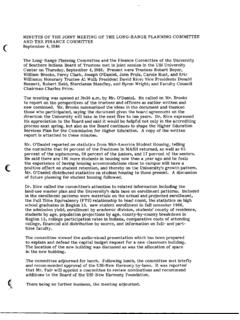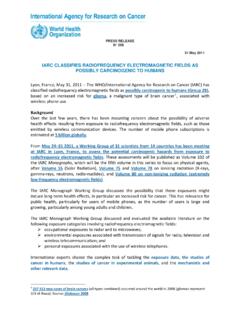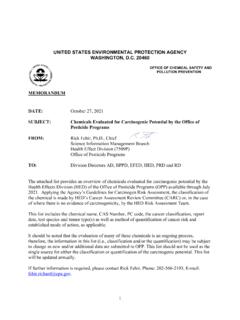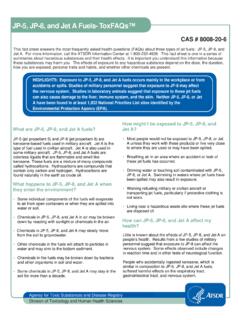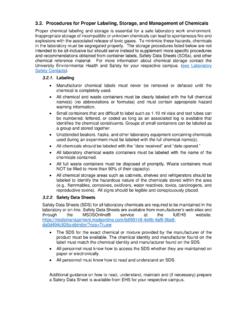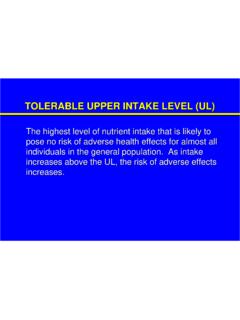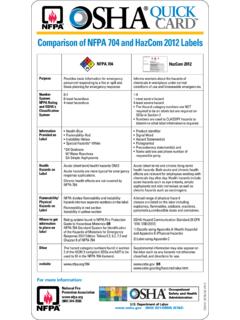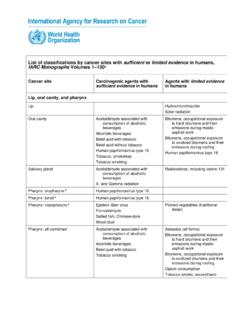Transcription of Chemical Hazards in the Workplace - University of Southern ...
1 Chemical Hazards in the WorkplaceChemicals in the Workplace There are 750,000 hazardous chemicals used in the Workplace around the world. Hundreds more are added every year. Chemicals are used for a variety of purposes. Employees must know how to protect themselves from Chemical is a Hazardous Chemical ? A hazardous Chemical is any substance that poses a physical or health hazard to you or others in the Chemicals Examples of Physical Hazards : Fires Explosions Examples of Health Hazards : Cancer Skin irritation Respiratory ailmentsHealth Hazards Health Hazards can be Acuteor Chronic Acute health Hazards occur rapidly after an exposure.
2 Chronic health Hazards occur gradually after repeated Hazards The methods in which chemicals enter the body are called routes of entry. Understanding these various routes of entry is necessary to prevent exposure to hazardous chemicals. There are three main Routes of Entry Absorption Inhalation IngestionRoutes of Entry Absorption Occurs when contact with exposed skin allows a Chemical to be absorbed into the body. To prevent absorption, wear proper protective equipment: Chemical gloves Aprons CoverallsRoutes of Entry Inhalation Can occur when chemicals become airborne in the form of a vapor, mist or dust allowing them to be inhaled into the lungs.
3 To prevent inhaling hazardous chemicals you must select and use proper respiratory of Entry Ingestion Can occur when hazardous chemicals are eaten or swallowed. To avoid ingesting hazardous chemicals never: eat drink apply make-up Always wash hands after handling chemicals.
4 Chemical Hazards There are three main sources of information used to convey a Chemical s Hazards Chemical Manufacturer s Label Supplemental Hazard Labels Material Safety Data SheetsHealthFlammabilityReactivityManufa cturer s Labels The Chemical manufacturer s label is the first source of information about potential Hazards , safe work practices and PPE required for a specific s Labels Manufacturer s labels provide the following information Commercial name of the Chemical Name and address of the manufacturer Any physical or health Hazards presented by the chemicalManufacturer s Label Some manufacturer s labels include additional information such as.
5 Required PPE to be worn Special handling Storage requirements First aid Spill clean upSupplemental labels Additional supplemental labels are often used to quickly convey hazard information in an easy to read format NFPA HMISNFPA labels NFPA labels rank Hazards related to: Health Flammability Reactivity Special Warnings Each hazard is ranked on a scale from 0 to 4 HMIS labels HMIS labels use the same ranking and colors to display: Health Flammability Reactivity PPE Each hazard is ranked from 0 to 4 Other Labels Many companies have their own labeling system to identify Chemical Hazards .
6 Be sure you know and understand how to read the labeling systems used in your facility. If you have any questions ask your Labels Chemicals are often transferred from large containers to smaller secondary containers. When this occurs the secondary container must also be labeled. NEVERuse chemicals from an unlabeled Safety Data Sheets Material Safety Data Sheets are another source of information about a Chemical s Hazards Every Chemical in the Workplace has a Material Safety Data Sheet or MSDS MSDS contain more detailed information than labelsMaterial Safety Data Sheets Material Safety Data Sheets (MSDS) are readily available for employee review.
7 Make sure you know how to access these important documents. Always consult MSDS before working with any Safety Data Sheets MSDS sheets are divided and numbered into various sections, and while the arrangement of these sections may vary, most material safety data sheets contain the following valuable Safety Data Sheets Product and Company Information: This section will include the name of the Chemical and the manufacturer. An emergency contact number will also be Safety Data Sheets Hazardous Ingredients: This section will list the hazardous ingredients contained in the Chemical , specifically naming any known carcinogens.
8 Carcinogens are substances known to cause Safety Data Sheets Hazard Identification: This section will describe the Hazards posed by the Chemical . This will include physical Hazards , health Hazards and environmental Safety Data Sheets First Aid: When exposed to a Chemical , it s important to know what actions to take. This section will list what actions to take for specific exposure situations, such as contact with eyes, inhalation or Safety Data Sheets This section will list occupational exposure limits for the Chemical as well as required protective equip-ment to be used.
9 Refer to this section to determine if Chemical gloves, goggles or a respirator may be required. Also listed in this section will be any recommended engineering controls that may be required. Exposure Controls and Personal Protection:Material Safety Data Sheets This section will list properties such as boiling point, flashpoint, specific gravity, color and odor. This information can be used to predict how the Chemical will react under certain conditions and can also be used to help detect leaks and spills.
10 Physical and Chemical Properties:Material Safety Data Sheets Stability and Reactivity: This section describes how the Chemical will react when exposed to other chemicals, water, air, sunlight or other factors Some chemicals will react violently under certain conditions, if so it will be listed in this sectionMaterial Safety Data Sheets Handling and Storage: This section gives safe handling and storage instructions Following proper handling and storage instructions can prevent needless exposures and also prevent leaks, spills, fires or Safety Data Sheets Toxicological Information: Describes the various routes of entry for the Chemical and any acute or chronic health effects of exposureWritten Hazard Communication Plan Chemical labels and MSDS are just part of a larger written program maintained by the company to control exposure to hazardous chemicals.




